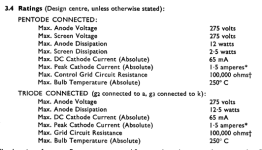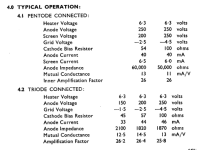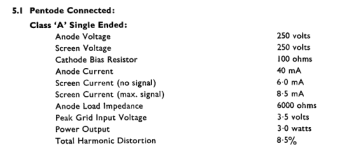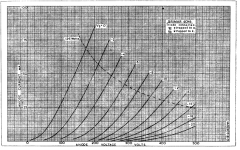AC heating owes to work best with the buffer version of course. I have seen the cleanest grass on FFT in all versions when with regulated DC heating nonetheless. AC heating harmonic noise can be helped with balancing resistors of grounded center in the secondary if necessary.
Salas,
Of course, you were right, 10k.
But, I made the mistake of Not stating in my post . . . that you have to use a bypass capacitor across the self bias resistor:
In that case we are talking about 5k rs (screen impedance).
That should be easy to verify by adding the bypass cap, and running LT Spice one more time.
That reminds me of Count Basie, he was recorded as saying: "One More Time". I am sorry, that is a bit obscure to many readers.
Happy Listening Everybody!
Of course, you were right, 10k.
But, I made the mistake of Not stating in my post . . . that you have to use a bypass capacitor across the self bias resistor:
In that case we are talking about 5k rs (screen impedance).
That should be easy to verify by adding the bypass cap, and running LT Spice one more time.
That reminds me of Count Basie, he was recorded as saying: "One More Time". I am sorry, that is a bit obscure to many readers.
Happy Listening Everybody!
Exactly, in my example circuit if the cathode resistor gets bypassed the gain climbs to 15.56dB and Zo drops to 5k. THD worsens by ~6dB at 0dBV ref level.
@Salas what's the point of 2.2uF at the output? Are you driving low Zin power amp or it's just the lowish plate resistor?
In the latter case I suspect it would work best with a good output transformer with 80-120H primary inductance and 4:1 ratio with bypass of cathode resistor. For example, the Lundahl LL1660 ALTQ is already finer in its standard 16 mA version but primary L could even better at 140-150H with air-gap for 108-10mA. This would also allow separation of ground loops between the preamp and power amp with great benefit for S/N ratio (basically leaving secondary floating and getting grounded in the power amp once connected).
If the Zin of the power amp is 50-100K or more the RC at the output could be modified with significantly lower C. ALL capacitors get worse when their value goes above 1uF, more or or less. The smaller the better!
In the latter case I suspect it would work best with a good output transformer with 80-120H primary inductance and 4:1 ratio with bypass of cathode resistor. For example, the Lundahl LL1660 ALTQ is already finer in its standard 16 mA version but primary L could even better at 140-150H with air-gap for 108-10mA. This would also allow separation of ground loops between the preamp and power amp with great benefit for S/N ratio (basically leaving secondary floating and getting grounded in the power amp once connected).
If the Zin of the power amp is 50-100K or more the RC at the output could be modified with significantly lower C. ALL capacitors get worse when their value goes above 1uF, more or or less. The smaller the better!
Last edited:
Hi, the point of 2.2uF is it can cover minimum phase turn coupling down to 10k-20k Zin amps. Which the CF and G3X versions can drive even better. They have 250Ω and 1kΩ Zout respectively. Of course lower (thus cheaper also) Cout values can do the job when for high Z input power amps. I originally used 0.68uF for example. In general I favor a -3dB high pass coupling point of 5Hz or less for minimum phase turn up to 100Hz.
A (cheap) tube like the 6CH6 might be better in this application with step-down transformer coupling. -3dB @5Hz should be easy with a LL1660 ALT Q gapped for 8 mA. Should be able to drive anything without CF's and without capacitors....
Attachments
45,
Thanks!
You indicated one way to match a preamp's output tube plate impedance, rp, to a lower output impedance is a step-down transformer.
What you reminded me of is one way to match a power amplifier's output tube's plate impedance, rp, to a lower impedance load . . .
is a step down transformer. Ome traditional way for a tube power amplifier.
The OTL, Output Transformer Less amplifiers, are not intrinsically a good impedance match; only with global negative feedback can an OTL properly drive a low impedance.
Thanks!
You indicated one way to match a preamp's output tube plate impedance, rp, to a lower output impedance is a step-down transformer.
What you reminded me of is one way to match a power amplifier's output tube's plate impedance, rp, to a lower impedance load . . .
is a step down transformer. Ome traditional way for a tube power amplifier.
The OTL, Output Transformer Less amplifiers, are not intrinsically a good impedance match; only with global negative feedback can an OTL properly drive a low impedance.
Hi, I also have problems with the movement of the woofer with DC voltage in a preamp project with 6GL7 tubes. How can I solve it? Thanks.Initial test done!
Hello again! Rough test gave very good results. The regulated supply did not hold up to more than 260 VDC B+ so I used a 17mA ,11.2V cathode operating point. Wire wound sandcast plate 5W resistors, 680R 1W generic carbon rk and generic Matsushita ck. Basic white Mundorf (SCR) coupler. The common cathode circuit was tested.
Well...bigger 3D, no edge, more reverb and depth info, more musical detail than the 6SN7 cc&cf or SRPP, or grid leak cc&cf, or 12AU7 cc&cf that have been used previously in the system.
Piano sounds superb and big drums too. Lots of air and body but no flatness or edge nowhere. Voices more liquid and human, better defined with better front to back spatial resolution. Strings are velvety, basses huge and open with no pace loss. Very good drive, optimal gain. Treble stems out seamlessly from upper mid naturally, not like a distinct entity.
Microphonicity is confined to a glassy low level 'ding' sound when hitting the 6V6 glass with a fingernail or when turning the stepped attenuator located right next to it. No locking with the feedback from the speaker just 0.5m near. After half an hour some periodic 'hsst' sounding transients showed up accompanied with woofers travelling on right channel but I am suspicious of the small regulated supply 12B4 pass element getting taxed with heat. Maybe it was the right 6V6 heater aswell, but I doubt it bcs of the cone travel, looks like a DC shift. I will test with heavier supply in due time. Now its given away to be further auditioned and inspected in longer term in another system by a fellow DIYer. If it turns to behave well in the long run it will very probably get adopted as my premium pre with proper custom PSU, best parts and antimicrophonic box build (there is more performance to be expected given the compromised B+ and generic components first test). Will keep you posted.
Hi, is it based on passively filtered B+? In such a case B+ can be modulated by the AC mains level slowly fluctuating then passing through the output capacitor as a charging/discharging pump. It is usually solved with adding a B+ regulator. Sufficient voltage drop margin should be available to it.
The same thing happened to me with the Aikido preamp and CRCRC filtering. The AC voltage can vary and this is reflected in the preamp output. And I don't have an input capacitor on the amplifier, and that's what happened. It was solved with CRC filtering and adding a voltage regulator. Now the supply voltage is a little lower (200VDC instead of 220VDC), but the problem is solved. I used the good old TL783C. Now it sounds even better than with the CRCRC. 😎
Last edited:
Yes, it should be taken into account from the start of the project. The only exception is if there is an output transformer in the preamplifier, it cannot transmit those slow voltage changes. But it is used less often, usually there is a capacitor at the output.
If the output amplifier is with tubes, I think there are no such problems. 😎
If the output amplifier is with tubes, I think there are no such problems. 😎
Hi Salas,
late as always I discovered this thread 🙈
I would build this preamp but in a balanced version (this only means 4 preamps instead of two).
Have you ever tried it in balanced mode? What is your opinion about common mode suppression?
Many thanks in advance!
Cheers
late as always I discovered this thread 🙈
I would build this preamp but in a balanced version (this only means 4 preamps instead of two).
Have you ever tried it in balanced mode? What is your opinion about common mode suppression?
Many thanks in advance!
Cheers
Does that mean push-pull with input and output transformer?balanced version
- Home
- Amplifiers
- Tubes / Valves
- 6V6 line preamp



